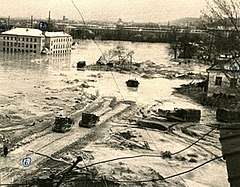1961 Kurenivka mudslide
The 1961 Kurenivka mudslide occurred on March 13 in Kiev, Ukrainian SSR, Soviet Union. The mudslide started at the edge of the Babi Yar mass murder site and dumped mud, water, and human remains into the streets of Kiev. The Soviet authorities suppressed information about the disaster, and claimed 145 people were killed, while forbidding any memorial events for the victims. A 2012 study in Ukraine estimates that the number of victims was closer to 1,500[1].
 Remediation works after the event | |
| Date | 13 March 1961 |
|---|---|
| Time | 09:20 (UTC+02:00) |
| Location | Babi Yar, Kyiv, Ukrainian SSR, Soviet Union |
| Type | Mudflow |
| Cause | Dam design flaws and poor maintenance |
| Deaths | 145 (Soviet official sources), up to 1500 (unofficial later investigations) |
Disaster
The mudslide started when a dam securing the loam pulp dump of a brick factory near the Babi Yar mass murder site collapsed after rain, releasing large volumes of pulp sludge, mud, water, and human remains down the steep hill of the modern Olena Teliha Street and into the streets of Kiev. The slide immediately hit the lower-lying Kurenivka neighbourhood, including a residential area, a tram depot, several industrial buildings and a cemetery, as well as cars and trams on its way. The total volume of pulp in the vicinity of Kyrylivska - Novokostiantynivska streets was up to 600 thousand m³ with a depth of up to 4 m. The official report indicated 145 fatalities, while a recent study estimates 1,500.[1][2]
Recovery operations
Recovery operations continued for days, but no official notification of the tragedy was ever published by the Soviet authorities.
Recovery operations were led by the 120 Detached Engineering Battalion and the Anti-gas Regiment of the Local Anti-Aircraft Defence troops of the Soviet Army in the Kiev Military District, led by the Hero of the Soviet Union Ivan Kharchenko. The events in Kurenivka were strictly censored by the Soviet Government. In order to cover up the scale of this disaster, many of the people who died were buried in different cemeteries in Kiev and its nearby towns with different dates and reasons for their death in the government records. No public remembrance activities were allowed and Soviet troops were sent to clear all visible consequences of the disaster.[3]
Aftermath

As a result of the subsequent investigation, several construction engineers and managers responsible for the dam’s design and maintenance were accused of negligence and convicted.
In 1962, Ukrainian Communist Party leaders ordered the leveling of the Babi Yar ravine and the establishment of a park on the site where at least 33,000 Jews from Kiev and surrounding areas had been shot to death in 1941 by the Einsatzgruppen.[4]
See also
References
- Harran, Marilyn, ed. (2000). "Epilogue: The Aftermath". The Holocaust Chronicle (1st ed.). Publications International. pp. 655–698. ISBN 978-0785329633.
- Smoliy, V. A.; Goryak, G. V.; Danilenko, V. M. (2012). Куренівська трагедія 13 березня 1961 р. у Києві: причини, обставини, наслідки. Документи і матеріали [Kurenivka Tragedy March 13, 1961 in Kiev: Causes, Circumstances, Consequences. Documents and materials] (in Ukrainian). Institute of Ukrainian History NAN Ukraine. p. 18. ISBN 978-966-02-6392-5.
- "The Kurenivka tragedy". www.visitkyiv.travel. Archived from the original on 2020-05-20. Retrieved 2019-08-21.
- "Memorial Complex Babi Yar". Information Portal to European Sites of Remembrance. Berlin, Germany: Stiftung Denkmal für die ermordeten Juden Europas. Retrieved 2020-02-28.
External links
- Google Maps Present-day satellite image centered on the area where the 1961 mudslide stopped
- Photographs of the disaster
- Kurenivka tragedy